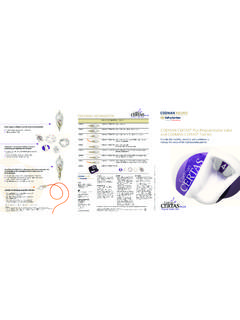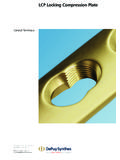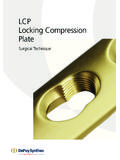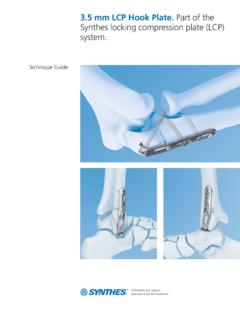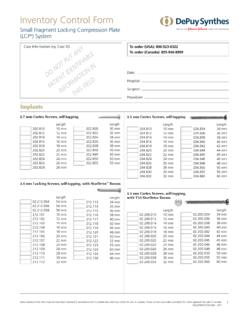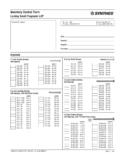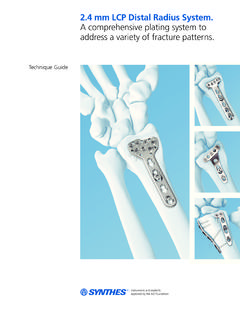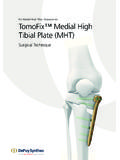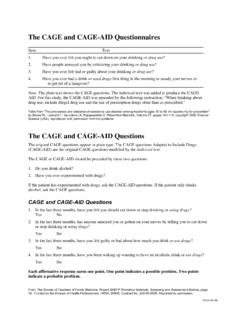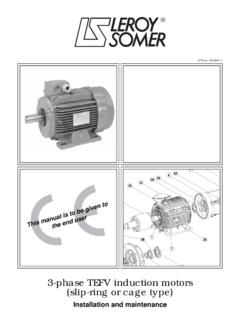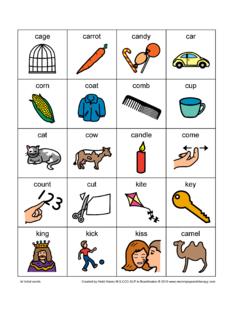Transcription of ORACLE CAGE SYSTEM - synthes.vo.llnwd.net
1 SURGICAL TECHNIQUEC omprehensive solution for lumbar interbody fusion using the direct lateral cage SYSTEMI nstruments and implants approved by the AO publication is not intended for distribution in the intensifier controlWar ningThis description alone does not provide sufficient background for direct use of DePuy Synthes products. Instruction by a surgeon experienced in handling these products is highly , Reprocessing, Care and MaintenanceFor general guidelines, function control and dismantling of multi-part instruments, as well as processing guidelines for implants, please contact your local sales representative or refer to: general information about reprocessing, care and maintenance of Synthes reusable devices, instrument trays and cases, please consult the Important Information leaflet (SE_023827) or refer to: cage SYSTEM Surgical Technique DePuy Synthes 1 INTRODUCTION ORACLE cage SYSTEM 2AO Principles 6 Indications and Contraindications 7 SURGICAL TECHNIQUE Preoperative Planning and Preparation 8 Patient Positioning 9 Access and Exposure 10 A.
2 Approach spine with tissue dissector 10 B. Approach spine with dilators 12 C. Approach spine with neuromonitoring 14 and tissue dissector or dilatorsSoft Tissue Retraction 16 A. Retraction with SynFrame 16 B. INSIGHT Lateral Access SYSTEM 16 C. Retraction with ORACLE access instruments 17 Discectomy 22 Prepare Endplates 25 Insert Trial Implant 26 Remove Trial Implant 27 Insert Implant 28 A: Insertion with implant holder 28 B: Insertion with lateral quick inserter distractor 30 Supplemental Fixation 33 PRODUCT INFORMATION Implants 34 Instruments 37 Sets 44 Additional Sets 51 Filling Material 52 BIBLIOGRAPHY 53 TABLE OF CONTENTS1 DePuy Synthes ORACLE cage SYSTEM Surgical TechniqueORACLE cage SYSTEMThe ORACLE cage SYSTEM is a modular and comprehensive set of implants and instruments designed
3 To support a direct lateral approach to the lumbar spine. The direct lateral approach is a minimally invasive approach that avoids direct exposure of the anterior vessels, and poste-rior nervous and bony access instrumentsRetractor Provides direct minimally invasive access to operative level Blades expand distally for additional accessRetractor accessories Light clip illuminates the surgical fi eld Intradiscal anchor and retractor pins increase retractor stability Blade extensions provide an additional 10 mm to the blade length in-situAPPROACHACCESSO racle cage SYSTEM Surgical Technique DePuy Synthes 1 ORACLE discectomy instruments Two styles of shavers, four-fl uted and two-fl uted, ream out disc material Bayoneted curettes ensure visibility while supporting a minimal exposure Instruments matte fi nish reduces glare from OR lightingOracle cage insertion instruments Trial implants self- distracting nose allows for ease of insertion Slide hammer provides force required for trial implant removal Lateral Quick Inserter Distractor inserts and distracts in one simple step, without impactionDISCECTOMYINSERTION4 DePuy Synthes ORACLE cage SYSTEM Surgical TechniqueOracle cage SystemOracle cage is designed to meet the specific demands of lateral lumbar interbody fusion procedures.
4 The im-plant is available in 4 medial/lateral lengths, 5 heights, and 2 sagittal profiles to accommodate various patient AND BENEFITSP yramidal teethProvide resistance to implant migrationLarge central canalAccommodates autogenous bone graft or bone graft substitute to allow fusion to occur through the cageSelf-distracting noseAllows for ease of insertionAnatomic shapeMimics the anatomy of the disc spaceFour radiographic marker pinsEnable visualization of implant positionThe medial/lateral marker pins are located approximately 4 mm from the edges of the implant. The anterior/posterior marker pins are located approximately 2 mm from the edges of the cage SYSTEM Surgical Technique DePuy Synthes 5 ORACLE cage is manufactured from a biocompatible poly-mer1 material embedded with four radiopaque marker pins, which allow the surgeon to radiographically deter-mine the exact position of the implant, both intraopera-tively and modulus of elasticity of the polymer is approximately between cancellous and cortical bone, which enables adequate compression of autograft in and around the implant, to aid in stress distribution and load Polyetheretherketone (PEEK)
5 6 DePuy Synthes ORACLE cage SYSTEM Surgical TechniqueAO PRINCIPLESIn 1958, the AO formulated four basic principles, which have become the guidelines for internal They are: Anatomical reduction Stable internal fixation Preservation of blood supply Early, active pain-free mobilizationThe fundamental aims of fracture treatment in the limbs and fusion of the spine are the same. A specific goal in the spine is returning as much function as possible to the injured neural M ller, M. Allg wer, R. Schneider, and H. Willenegger: AO Manual of Internal Fixation, 3rd Edition. Berlin; Springer-Verlag 19912 Aebi M, Arlet V, Webb JK (2007). AOSpine Manual (2 vols.), Stuttgart, New York: Thieme4 Principles as applied to the spine3 Anatomic alignmentIn the spine, this means reestablishing and maintaining the natural curvature and the protective function of the spine.
6 By regaining this natural anatomy, the biomechan-ics of the spine can be improved, and a reduction of pain can be experienced. Stable internal fixationIn the spine, the goal of internal fixation is to maintain not only the integrity of a mobile segment, but also to maintain the balance and the physiologic three-dimen-sional form of the A stable spinal segment allows bony fusion at the junction of the lamina and of blood supplyThe proper atraumatic technique enables minimal retrac-tion or disturbance of the nerve roots and dura, and maintains the stability of the facet joints. The ideal surgi-cal technique and implant design minimize damage to anatomical structures, facet capsules and soft tissue attachments remain intact, and create a physiological environment that facilitates , active mobilizationThe ability to restore normal spinal anatomy may permit the immediate reduction of pain, resulting in a more active, functional patient.
7 The reduction in pain and im-proved function can result when a stable spine is cage SYSTEM Surgical Technique DePuy Synthes 7 INDICATIONS AND CONTRAINDICATIONSI ntended UseThe ORACLE cage is intended to replace lumbar interver-tebral discs and to fuse the adjacent vertebral bodies to-gether at vertebral levels L1 to L5. Additionally, the use of autogenous bone or bone graft substitute as well as supplemental fixation is always recommended. ORACLE implants are inserted via the lateral pathologies with indicated segmental spondy-lodesis, : Degenerative disc diseases and spinal instabilities Revision procedures for post-discectomy syndrome Pseudoarthrosis or failed spondylodesis Degenerative spondylolisthesis Isthmic spondylolisthesisOracle cage is intended to be used in combination with supplemental Vertebral body fractures Spinal tumors Major spinal instabilities Primary spinal deformities Two-level lateral view of ORACLE and Pangea immediately DePuy Synthes ORACLE cage SYSTEM Surgical TechniqueSURGICAL TECHNIQUE1 Preoperative Planning and SynFrame Basic SYSTEM in Vario Case* Set SynFrame RL.
8 Lumbar** ORACLE Access Instrument Stability SYSTEM Set for MIS Support INSIGHT Lateral Access SYSTEM ORACLE Discectomy Instrument ORACLE cage Insertion Instrument SetOptional Neuromonitoring Stimulation Electrode Kit for Handle for Neuromonitoring Stimulation Retractor Light Clip for ORACLE Retractor, Dilation Instrument Set for Minimally Invasive Posterior Instuments Have all necessary imaging studies readily available to plan implant placement and visualize individual patient all sets readily available prior to surgery.* SynFrame Basic SYSTEM contains instruments that allow for direct mounting to the operating table.** SynFrame RL, lumbar contains radiolucent soft tissue retractors and semi-transparent bone cage SYSTEM Surgical Technique DePuy Synthes 92 Patient PositioningOptional Electrode Kit for NeuromonitoringPlace the patient in a lateral decubitus position.
9 A bolster placed underneath the hip, to aid in opening the space between the twelfth rib and iliac crest, is recommended. It is also recommended to flex the table, to aid in open-ing the space between the twelfth rib and iliac crest. En-sure that the rotational alignment is correct. Secure the patient to the table. Precaution: Prevent undue pressure points when po-sitioning and securing the : If neuromonitoring is planned, the neuro-physiologist or neuromonitoring technician should apply all appropriate electrodes prior to patient respective neuromonitoring surgical technique for details of Neuromonitoring Kit the universal arm and table clamp to stabilize the retractor to the OR table. Turn the table clamp lever counterclockwise to loosen.
10 Slide the table clamp onto the OR table the post of the universal arm through the opening of the table clamp with the articulation of the arm fac-ing the patient. Turn the table clamp lever clockwise to DePuy Synthes ORACLE cage SYSTEM Surgical TechniqueSurgical Technique3 Access and ExposureLocate the correct operative level and incision with fluo-roscopic views. Make a skin incision targeting the ante-rior third of the intervertebral disc space. Note: Use a longitudinal incision if multiple levels will be Approach spine with tissue Tissue DissectorOnce the skin incision is made and the subcutaneous tis-sue is taken down, the oblique muscles of the abdomen should be visible. Separate the muscle fibers with blunt dissection and enter the retroperitoneal space (1).
